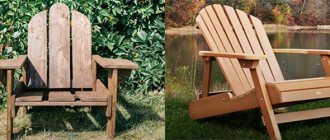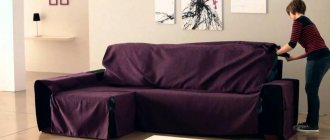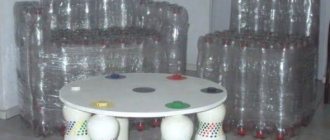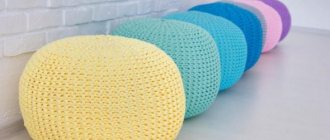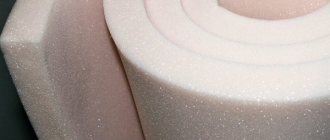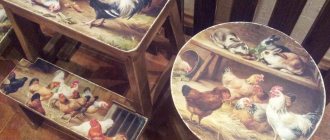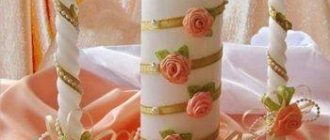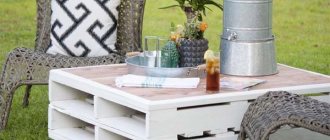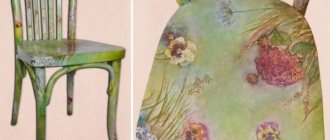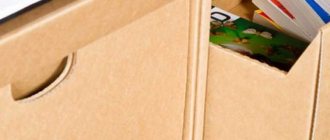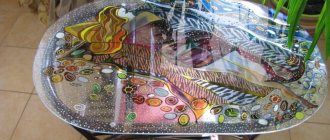The absence of a frame allows the product to completely follow the curves of the body.
In addition, the chair is characterized by mobility, light weight and ease of use.
Features of upholstered frameless furniture
A design feature is the absence of a rigid frame. The bean bag chair is made in two sizes – 50 and 100 cm in diameter. This depends on the height and weight of the users, as well as the purpose of the room.
This frameless furniture consists of two covers: internal and external. The removable cover is made from different materials (cotton, linen, velvet, fur, leatherette) .
And the main requirement for the inner cover is strength and high density of the fabric.
The main thing is that the selected materials are practical, wear-resistant, pleasant to the touch and fit harmoniously into the environment. Attention : after some time of use, the chair may shrink.
The situation is corrected by adding filler to the inner case. The peculiarity of a frameless chair is that under the weight of a person it completely takes on the shape of a vacationer. On such products, people can completely relax and unwind with a book or laptop in their hands.
The advantages of frameless furniture include:
Wide range of applications . The bean bag chair will fit harmoniously into a child's room, living room or bedroom, as well as into landscape design.- Light weight . The average weight of furniture varies from 7 to 10 kg. This makes it easier for her to move around the house.
- Original appearance .
The removable cover is made from a variety of materials. They differ in colors and fabric textures. You can make a bright and colorful cover in the shape of an animal’s face for your child’s room. - Possibility of outdoor use . The furniture fits harmoniously into any landscape design. The use of modern fillers and the use of waterproof, wear-resistant fabric for sewing the top cover allows it to be used in the warm season outdoors.
Features of a bean bag chair
The main feature of this design is the absence of a frame, which is characterized by rigidity and strength. In its classic form, it is presented in the form of a pear. It is a large fabric bag filled with various bulk materials. An unusual effect is created, as if a person is sitting on a water mattress. The product takes the shape of the body, so the weight is distributed evenly.
Bean bag chairs are created by many people at home, as this makes it possible to get a unique product that fits perfectly into the interior. This allows you not to spend a lot of money on its purchase.
After a short period of use of this chair, complete relaxation of the back muscles is ensured, so the load is removed from it. An easy chair is usually stuffed with foam plastic or other materials that have excellent thermal insulation parameters, so the design additionally has a warming effect.
Bean bag chairs are presented in numerous types, and they differ not only in size, but also in shape. It is easy to select a product that is suitable for a child or an adult, and also has a configuration in the form of a pear or a circle, a rectangle or an unusual shape. Below are many photos of these products, so when creating a chair yourself, it’s easy to choose the best option.
Scheme
The advantages of their use include the following factors:
- since loose fillers are used, the product is comfortable to use;
- furniture without a frame is safe, since it has no corners, so it is effectively used in a children's room;
- a hand-made element will fit perfectly into the interior;
- Only environmentally friendly materials are used in the work process;
- the chair moves easily around the room, making cleaning easier;
- The removable outer cover can be washed periodically, so maintenance is simple.
If the old product no longer fits into the interior, you can make a new and bright outer cover for it, which will update any room.
Dimensions
Shapes: pear, ball and drop
A bean bag chair can have different shapes. But the most popular and in demand are:
Pear .
Externally it resembles a frame product. It is equipped with an elongated upper part that acts as a backrest. When you sit on the chair, comfortable soft armrests appear. The pear chair is a classic and common type.- Ball . Externally, the chair looks more like a couch, since it does not have a pronounced back. Two ball chairs look beautiful in the interior - a large one for sitting, a small one for a footrest.
- A drop . It is sewn not in the form of hexagons, unlike the ball model, but in the form of a drop. It, like other models, easily takes the shape of a resting person, is soft and easy to use.
Materials
Different materials are used to sew the outer cover. The main thing is that they have:
- abrasion resistance and high strength;
- ease of care;
- attractiveness.
What is the cover made of?
As a removable cover, different materials are used to make a bean bag chair:
Oxford is a popular upholstery fabric with an aesthetic appearance and high technical qualities.
It does not get wet, which allows you to use furniture outdoors and is pleasant to the touch. It is easily machine washable and does not absorb dust, dirt or unpleasant odors.- Faux leather . It is easy to care for and comes in a wide range of colors. This fabric is suitable for outdoor use. Since it is not afraid of increased moisture and sudden temperature changes. Also, artificial leather is not afraid of exposure to sunlight and ultraviolet rays. In other words, the material is versatile, practical and wear-resistant.
- Flock . Pleases consumers with a pleasant and velvety texture. The fabric is practical, durable and resistant to negative factors. Even if there are pets in the house who love to relax on upholstered furniture, there will be no problems with care. Since dirt, wool and unpleasant odors are easily removed from the surface of the flock.
- Microvelvet . The material amazes customers with a large selection of shades. It is easy to care for and has high technical characteristics.
- Velor . It is distinguished by softness, interesting colors, and versatility. You can sew a chair from velor for both an adult and a children's model.
Tip : the inner cover is made from denser fabrics. A good choice would be spunbond with perforations for ventilation. This fabric is sold in rolls and is characterized by its low cost and high technical qualities.
Filler
As for fillers, you can use:
Expanded polystyrene .
It is sold in the form of granules or balls. Depending on the size of the furniture item, you will need to buy 1-2 packages of material weighing 60 liters. Its advantages include: high hygiene and hygroscopicity, light weight, wear resistance, resistance to high moisture, and the ability to withstand heavy loads. The material does not absorb water and sweat, and is suitable for making children's furniture.- Foam rubber and polystyrene foam granules . Double filling, used in a ratio of 70% polystyrene foam and 30% foam rubber, will allow vacationers to experience maximum comfort.
- Bean filler . Some people use peas, beans or beans to fill frameless furniture. This creative approach will allow you to make a budget chair model with high technical characteristics. It is worth considering here that legumes absorb moisture and attract rodents.
- Old things . To make the chair really inexpensive, you can use unnecessary old things as filler. Here it is recommended to choose softer materials.
How to sew a frameless sofa with your own hands
How to sew a frameless sofa with your own hands
The torment lasted for a long time... The main thing is to make up your mind and get into the problem headlong, and then begin to resolve it. The first point (and the most pleasantly quick one) is to throw away the old boring wooden folding sofa that twists your spine. Point two is to go shopping and realize that there is nothing that satisfies your needs. The most important obstacle was my husband's skeptical attitude. Therefore - point three - put your husband on a camping mat and soak for two to three weeks. He is my main critic and evaluator of the viability of my unstoppable endeavors. The initial data were disappointing. The room is just over 15 square meters. It contains: a full-size bed for a teenage child with an orthopedic mattress, a large closet for him, a workplace for preparing homework, a “wall” like a relic of the past, but terribly comfortable and capacious, a table on wheels (my seamstress’s workplace). There remains a very small area of free space. But my husband and I (due to age and accompanying chondrotic manifestations) became completely unbearable to sleep on small-sized sliding sofas... We wanted space and freely outstretched arms and legs. In addition, I vitally need a section of floor measuring approximately 2 * 3.5 m for laying pleating. In short, as a mathematician, it was clear in my head that two and two are not four, but as much as needed. Having looked up all the information on the global web, I came to the disappointing conclusion that you can only help yourself with your own hands. And one conclusion suggested itself - we are making a frameless transforming sofa. The conclusion was obvious, but the input... Fortunately, we live not far from an enterprise that produces furniture foam rubber (foam rubber in common parlance). We strained ourselves and persuaded them to make us pillows from the right brand in the right sizes. Well, then it’s a matter of technology. 10m of lining fabric, 10m of flock, a week of work - and voila.
Frontal view. The beige-chocolate combination is a compromise between daytime practicality (we like to drink coffee there) and at least some hint of bright positivity.
The “ears” swing open, I don’t recommend sitting, and folding your legs during the day is really okay 
This is what the transformation into a sleeping place (210*160cm) looks like:
And further:
You can’t feel the seams between the pillows at all (there were such concerns), but in the legs - this is no longer important. Here are views from other angles - from the side and from the back.
In essence, this design is pillows sewn together. They were sewn together during the process, valves were sewn inside along the entire length, the width was within 7-8mm.
The foam rubber is initially lined with lining fabric (reduces wear and simplifies the process of pushing into the covers). It took 8 meters of lightning for 4 pillows and 2 hidden ones for the armrests.
Pillow stitching pattern:
and further:
Stages of work: 1. Order 4 pillows made of polyurethane foam, dimensions in mm 225*225*1600, 225*800*1600, 225*575*1600, 225*500*1600. 2. I sheathed each one tightly separately with lining fabric. 3. I sewed a flock cover for each pillow with a “zipper” in the end edges along the longest side, extending to the sides; if the long side is 1600mm, the zipper is 2m, then you get a 20cm zipper on the sides. otherwise it is very difficult to insert the pillow inside. Along the way I sewed in connecting valves. The parts were cut out with an allowance of 1 cm on each side, this is enough to make it tight, but without excessive tightening. I really regret that there are no photos of the stages of creation, I was carried away by the process, somehow I had no time for it. There are no armrests in the diagram, they were not initially provided for, they appeared in the process (sewn to pillow 3). PPU brand HR3535 can withstand loads of up to 120 kg on load-bearing surfaces. It feels like a fairly firm orthopedic mattress when you sit down (or lie down). Dimensions when assembled: 800*1600mm (based on floor area). Pros: absolute mobility, does not scratch the floor, lightweight (total weight just under 30 kg), husband does not push, maintainability. Admire, praise, ask, I’ll be glad!
2. I sheathed each one tightly separately with lining fabric. 3. I sewed a flock cover for each pillow with a “zipper” in the end edges along the longest side, extending to the sides; if the long side is 1600mm, the zipper is 2m, then you get a 20cm zipper on the sides. otherwise it is very difficult to insert the pillow inside. Along the way I sewed in connecting valves. The parts were cut out with an allowance of 1 cm on each side, this is enough to make it tight, but without excessive tightening. I really regret that there are no photos of the stages of creation, I was carried away by the process, somehow I had no time for it. There are no armrests in the diagram, they were not initially provided for, they appeared in the process (sewn to pillow 3). PPU brand HR3535 can withstand loads of up to 120 kg on load-bearing surfaces. It feels like a fairly firm orthopedic mattress when you sit down (or lie down). Dimensions when assembled: 800*1600mm (based on floor area). Pros: absolute mobility, does not scratch the floor, lightweight (total weight just under 30 kg), husband does not push, maintainability. Admire, praise, ask, I’ll be glad!
Author: Olga Volchik (vololga)
Recommended material for you Rate your homemade product, master class, idea. Comments
Pattern with detailed dimensions for children and adults
To make a pear chair you will need to make a pattern. You can draw it yourself or find a ready-made version on the Internet.
The pattern is drawn on graph paper. And then it is transferred to the fabric. The parts are cut along the contour.
Attention : when transferring the pattern to the fabric, do not forget to leave allowances of a few centimeters on each side.
The pattern of a chair for an adult will consist of the following parts:
- 6 pieces of wedge-shaped parts, 15 cm wide and 40 at the ends, with a diameter of 50 cm and a length of 130 cm;
- diamond-shaped top 15 cm on each side;
- The bottom is diamond-shaped, 40 cm on each side.
The pattern of a chair for a child will consist of the following 6 wedge-shaped parts:
- height – 90 cm;
- diameter – 45 cm;
- width – 40-22 cm.
The bean bag chair consists of:
- Internal zippered cover filled with polystyrene foam. Here you should choose thick cotton or raincoat fabric.
- Outer cover. Suitable for manufacturing: corduroy, leather, velor. You will need to sew a 1 meter long zipper onto the removable cover.
Step-by-step master class on sewing a chair
The frameless design of the chair allows you to adapt it to any needs and requirements. With your own hands you can make a comfortable seat for an adult or a child, and direct the backrest at a certain angle. After choosing the appropriate model, size and type of fabric, you can proceed to making the chair. All work is carried out in stages, starting with the preparation of tools and materials and ending with stitching a stylish furniture accessory.
Required materials and tools
The first point of instructions for any master class is the preparation of tools and materials. To create a frameless ottoman with a back or a soft sofa you will need the following items:
- Textile. You will need two types of material - thick and breathable for the inner cover, and decorative upholstery for the outer cover;
- Threads. Structural elements can only be fastened with reinforced high-strength fibers with a polyester core;
- Lightning. To make the covers airtight you will need two zippers, tractor or spiral;
- Sewing machine. Speeds up the stitching process and ensures even, strong stitches.
- Tailor's large scissors, chalk. For convenient marking and quick cutting of patterns;
- Filler. I often use expanded polystyrene to stuff the inner cover. Its quantity depends on the size of the chair.
Pattern and order of sewing a cover
Any frameless chair with filling consists of two covers of approximately the same size. The color and texture of the bottom part does not matter. The main requirement is durable material. The outer cover must fit into the interior of the room.
First of all, you need to make patterns. Special paper with a 2-5 cm square is suitable for this work. We mark the parts according to a pre-designed size using a pattern, cut them out, apply them to the smoothed fabric and outline them with chalk. Sewing a bean bag chair is very simple, it takes place in several stages:
- We transfer the patterns to the fabric and cut them out;
- We connect the largest part with the sides, sew it together, leaving room for a zipper on one side;
- Sew on the round bottom and seat. We apply the zipper and attach it;
- In the upper part we make holes for air to escape and sew on a comfortable handle;
- In the same way, we prepare a slightly larger cover from decorative fabric.
When cutting each part of the inner and outer cover, you need to leave a few centimeters for the seams.
Filling the filler
Stuffing is the very last, critical stage in the manufacture of a bean bag chair. One of the covers must be filled 2/3 with foam balls. You should not immediately turn the bag of filler into the bag, especially if you try to push the granules with your hands. Airy and unruly elements will scatter like white snow throughout the room.
In this case, a paper funnel or a plastic bottle without a bottom or neck will help. A landscape sheet of paper should be rolled into a cone, secured with tape or glue and placed in the chair bag. Tighten the zipper well. Place a bag of polystyrene foam on the upper, wider part, secure it and gradually pour out the contents. You can use a plastic bottle using the same principle.
Thanks to simple steps, you can quickly and without loss fill the chair with light granules. This method is used when adding contents, when the balls have settled and flattened.
Master class on how to sew it yourself at home step by step
After making a pattern on the material, it’s time to sew a bean bag chair with your own hands:
First, the parts are fastened to each other with needles and side seams are basted on them.- Next, the seams are sewn with a sewing machine, and the product is smoothed with an iron.
- The outer wedges are folded on the blanks and basted.
- The inner cover is sewn together. A zipper, 40 cm long, is sewn onto one of its sides. The filler will be poured through it in the future. The seams of the product are processed using an overlock machine .
- Let's start making the removable outer cover. A 1 meter long zipper will be sewn into it.
- Both covers are turned inside out and the top is sewn to the outer cover.
- The bottom of both covers is ground off and the circles are attached.
- The product is turned right side out.
Now all that remains is to fill the chair with polystyrene foam and you can install the piece of furniture in the interior.
Attention : polystyrene foam clings to all surfaces.
If you scatter it around the room, the cleaning process will take a long time.
Filler selection
To sew a frameless bean bag chair with your own hands, you can use different fillings. Each material has certain characteristics. Some are unacceptable for allergy sufferers, others are too expensive, and others are unsuitable for outdoor use. However, all existing types can be divided into several main categories:
Natural:
- wood shavings and sawdust;
- poultry feathers;
- horsehair;
- wool;
- buckwheat husk.
Synthetic:
- expanded polystyrene;
- polypropylene;
- polyurethane foam;
- holofiber.
Available materials:
- cereals;
- legumes;
- hay, straw;
- paper;
- pieces of foam rubber;
- cotton wool;
- old clothes, textiles.
There is a wide variety of raw materials that can be used to fill frameless furniture. The main thing is to make the right choice of fabric for sewing the cover, through which the used filler will not leak.
Step-by-step operating instructions
To ensure that a piece of furniture serves its owners for as long as possible, it is recommended:
Periodically add filler to it. Thus, the product will retain its original shape.- Do not place the chair near heating appliances (radiators, stoves, fireplaces).
- Protect furniture from prolonged exposure to direct sunlight. This will cause the material to fade .
- Do not use bleaches or stain removers containing ammonia.
- Wash the outer cover on a delicate cycle, according to the fabric manufacturer's recommendations.
As you can see from all of the above, a bean bag chair does not require much work . And with proper use, it will serve its owners for many years.
Tip : if you like comfortable upholstered furniture, try making a hammock chair or a chair from tires. And next to them a coffee or glass table and even an ottoman will look good.
Photo
Your efforts will be rewarded - you will receive stylish and comfortable furniture that will decorate any interior:
